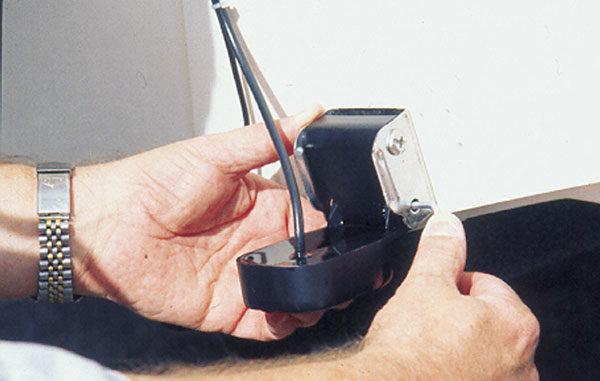
Transducers are much like television antennas — both must be mounted in the right place and carefully aimed to deliver top performance. A boat’s transducer must be installed where it maintains constant contact with the water as the craft runs and maneuvers at its top speed or pounds through waves in rough weather.
There are three types of transducers, and choosing the best one for your boat depends on your hull design and the kind of water you expect to keep under it.
Transducers can be glued down inside a boat with hard-drying epoxy that lets them shoot sound through the part of the hull directly under them. Shoot-through installations are common on high speed boats because the transducer generates no extra drag.
They are sometimes the only choice for fast boats with exotic transom designs that don’t offer a good place to mount an external transducer’s bracket. They are also popular with freshwater fishermen who get back in standing timber because they aren’t as easily damaged as exposed transducers.
On the down side, temperature and speed probes built into transducers can’t work through a hull, and not all fish-finder manufacturers offer separate speed and temp sensors to support shoot-through installations.
Depth penetration is another worry. Some sound is absorbed by the hull so shoot-through installations are not the best choice for use in water depths close to a fish-finder’s maximum reach.
Transducers cannot shoot through wooden hulls or fiberglass hulls with internal layers of foam core. Boats with hulls and inner liners separated by a layer of foam flotation or an air gap are also not candidates for shoot-through installations.
Aluminum hulls are no longer ruled out, but they require special transducers designed with metal hulls in mind for best results.
True through-hull transducers mount outside on the bottom of a hull, secured by a gasket, washer and nut on a threaded stem that passes through a hole up into the boat. These transducers are popular on large boats with displacement hulls, and are usually mounted forward of the transom near the deepest running area of the hull.
A streamlined and angled faring is usually mounted between the transducer and the outside of the hull to compensate for hull deadrise and to let the transducer shoot straight down.
Some through-hull models are designed with only a thin, streamlined segment outside the hull for use with fast, planing hulls.
The exposed faces of through-hull transducers offer maximum depth penetration and can include speed and temperature sensors.
Disadvantages include too much drag for smaller hulls at high speeds and the need for a mounting hole in the hull that some boat owners dread. If the transducer and faring collide with an underwater obstruction, hull damage and serious leaks are possible.
Transducers that mount outside on a transom bracket are the most common type packaged with fish finders. Most now have temperature sensors built in, and some accept snap-on, paddle-wheel speed sensors. They work with any hull material, and their brackets allow a wide range of adjustment for special circumstances. The brackets also let transducers kick up during collisions with submerged objects.
Drilling bracket mounting holes in the transom presents a potential drawback as these holes can leak if they aren’t properly sealed. The running depth and mounting angle of these transducers is critical to good high speed performance, and it isn’t always possible to make them work at the speeds that shoot-through-hull transducers can handle.
All three types perform well if they are properly installed. Most sonar problems are the direct result of an improper transducer installation, so after you pick one, seek professional help if you doubt your ability to do a top-notch job.


